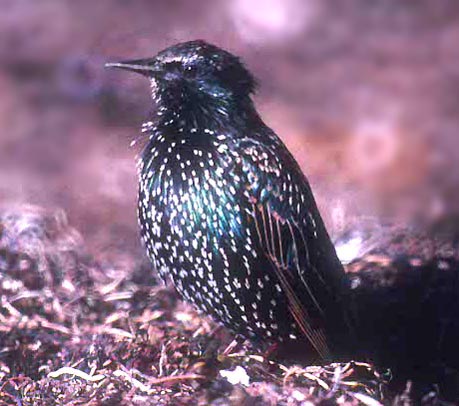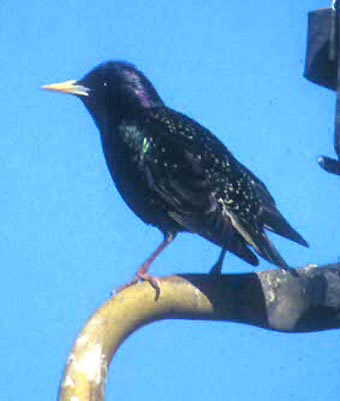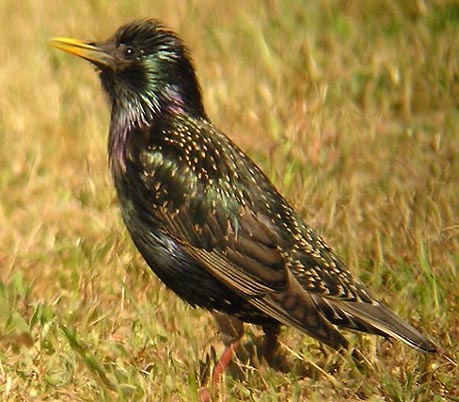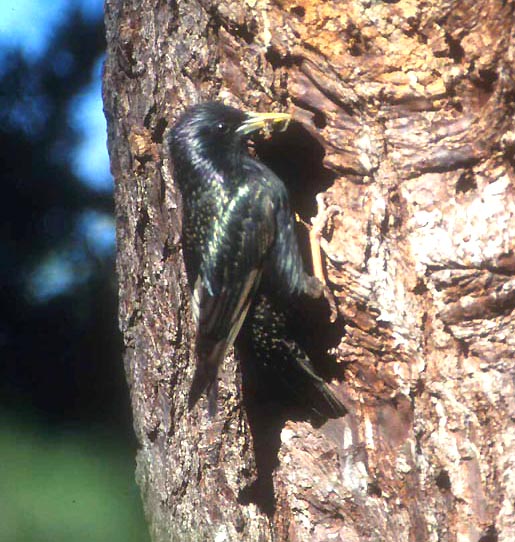 The
non-native European Starling is the bane of the local avian world. Its
a pretty enough bird and has some engaging behaviors, but unfortunately
its burgeoning population has devastated locale hole-nesting species. Do
you recall the old political machine in Chicago, where they urged residents
to "vote early and often"? Starlings don't vote... they breed. And they
breed early and often They like to use old woodpecker holes (right)
and have often taken the best sites by late March before nesting swallows
or Purple Martins arrive. They are also aggressive, and will drive a Hairy
Woodpecker from a newly excavated site. Breeding Bird Atlas data shows
that most pairs have two broods of 2-5 youngsters each year. The
non-native European Starling is the bane of the local avian world. Its
a pretty enough bird and has some engaging behaviors, but unfortunately
its burgeoning population has devastated locale hole-nesting species. Do
you recall the old political machine in Chicago, where they urged residents
to "vote early and often"? Starlings don't vote... they breed. And they
breed early and often They like to use old woodpecker holes (right)
and have often taken the best sites by late March before nesting swallows
or Purple Martins arrive. They are also aggressive, and will drive a Hairy
Woodpecker from a newly excavated site. Breeding Bird Atlas data shows
that most pairs have two broods of 2-5 youngsters each year.
European Starlings were introduced from Europe to New York City in 1890. This misguided introduction "took" and birds rapidly spread across industrialized America. Starlings first reach California in 1952 and were recorded in Carmel Valley, Monterey Co., by June 1953. By 1954 "dozens" were in Moss Landing and 50 in Gonzales by 1955 (Roberson & Tenney 1993). Today, starlings breed everywhere in MTY except for the remote canyons on the Big Sur coast and at higher elevations in the Ventana Wilderness (above ~4000' elevation is a starling-free zone). Starlings are apparently responsible for the extirpation of Purple Martins from the Monterey Peninsula by 1957 and in Carmel Valley by 1966. Purple Martins are today found only in remote wilderness or coastal Big Sur areas with few or no starlings. Recent Christmas Bird Counts have averaged about 1800-2000 starlings. Starlings do not have complex plumage stages. Youngsters in the nest (below; top photo) are uniformly gray with broad yellow gular flanges. The flanges retract after fledging (below; second photo) but the retained juvenal plumage is all gray with a white throat. Juvenal plumage is not held for long (just a month) and is replaced by a complete molt once abandoned by their parents between June-November (depending on when they were hatched). |
 |
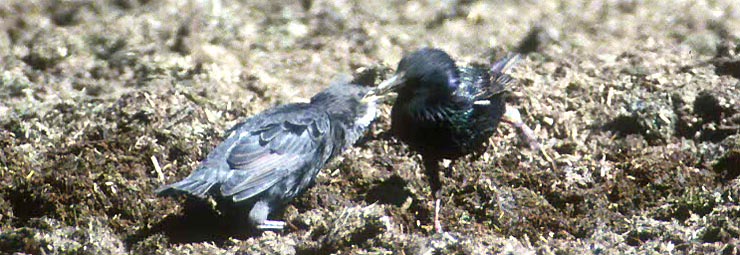 |
|
top two photos of adult Starling at nest
hole &
youngster in the nest were taken 5 June 2002 in Pacific Grove; shot of fledged juvenal being fed is 22 June 1997 at horse corral at A. Molera SP (yes, they're standing in manure); all 3 shots © Don Roberson |
|
European Starling undergoes only one molt per year — for adults this is after breeding and occurs between July-October. The top two photos below show very fresh adults in August-September. The plumage is glossy black with much greenish and purple iridescence. The body is prominently spotted with white; secondaries, tertials, and wing coverts are broadly edged with cinnamon. North American starlings of are the nominate race vulgaris. According to Pyle (1997) Identification Guide to North American Birds, Part 1, males may be separated from females in adult plumage (and sometimes earlier) by bill and eye color. Males have entirely dark brown eyes and a bluish base to the yellow bill in spring; females have a yellowish outer ring to the iris and a pinkish base to the yellow bill. Isn't that sweet? Males baby blue, females pink. Looking at the photos on this page, it seems to me that I've only photographed males. |

